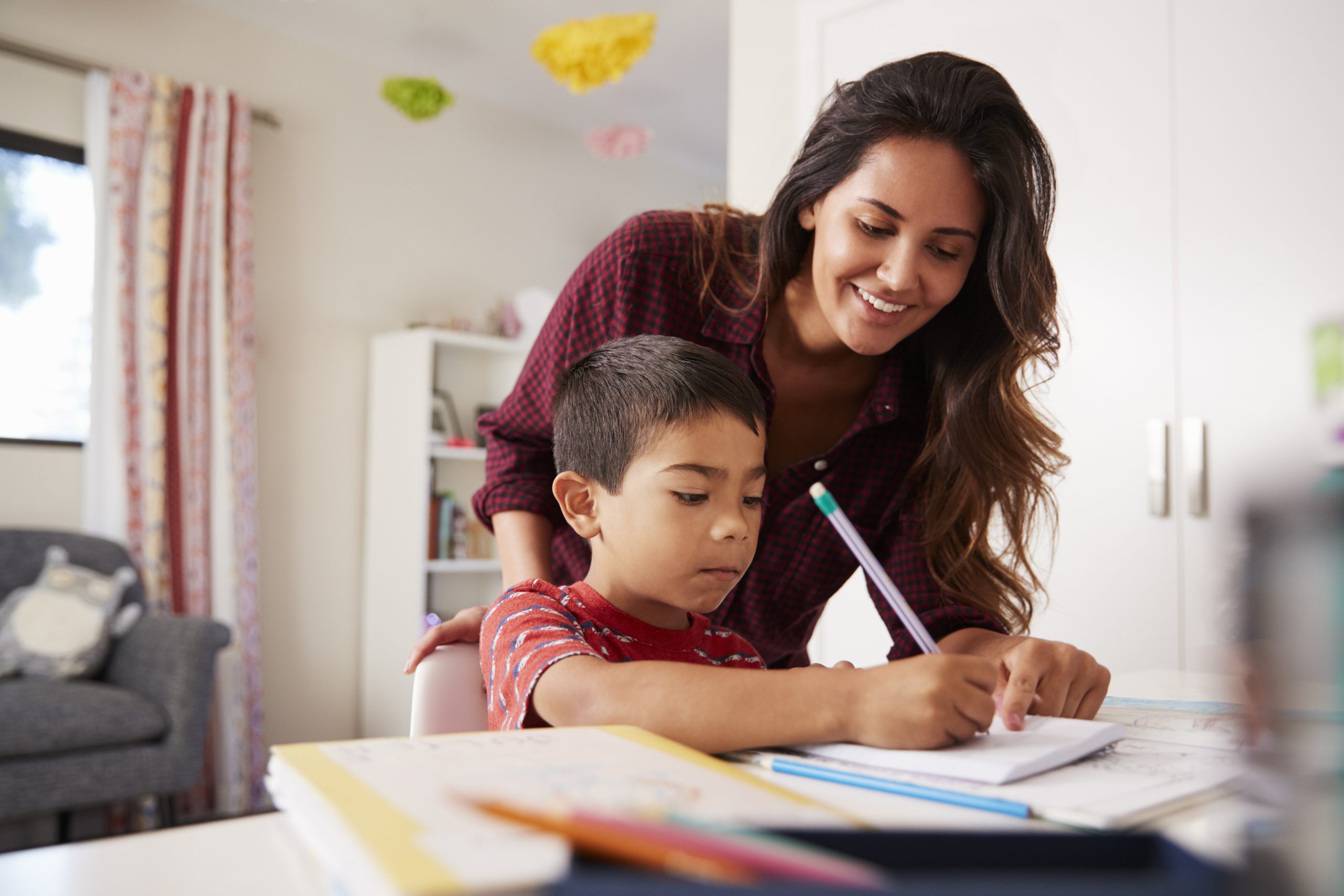Did you know that supporting your children’s learning from home can help them develop better reading skills later on?[1] Plus, studies have shown this to be the case through high school. Anything you do to support home learning can have a lasting impact on your child’s academic success.[2]
Here are some tips to help you create an effective home learning environment. Whether you’re homeschooling, managing remote learning, or just setting up a homework space for your child, it’s easy to set up an excellent learning space for your young learner.
 1. Use routines to structure your at-home learning.
1. Use routines to structure your at-home learning.
Children work best with a routine where they know what to expect every day. Help your child create a structured schedule for their learning in a way that works best for them.
Structure could take many forms: even making sure that your child works on assignments at the same time every day can go a long way. Whatever form of consistency you can provide for your child will help them learn better at home.
2. Create a designated learning space for your child.
This tip ties into creating a structure for your child’s learning routine. If you can find a space where your child works on assignments every day, they’ll be able to get into a learning mindset faster.
When possible, create an area that is dedicated solely to your child’s assignments. If you don’t have the space in your home, however, any table or desk with free space can work well. The important thing is using the same space every day.
3. Remove distractions when possible.
Once you’ve set up your home learning space, brainstorm any potential distractions with your child so you can remove them from the area. For some children, this could involve blocking certain websites while they’re using a computer to complete work. Others might need you to move toys out of the room so they’re not tempted to play during homework time.
Keep in mind, though, that some kids might work better with a little music or noise in the background.[3] Eliminating distractions is all about determining what helps your child work at their highest potential and avoiding things that detract from that.
4. Teach your child the importance of time management.
Sometimes if a child has more than one assignment, they may feel overwhelmed and have trouble determining where to start. That’s where time management comes in.[4]
Help your child arrange their assignments from most to least important to finish today. That way, they can work independently in a way that helps them get the most out of each day. If they aren’t sure which assignments are most important, try getting in touch with their teacher or suggesting which assignments to start with.
5. Think about home learning beyond school assignments.
Home learning doesn’t always begin and end with homework assignments. Try to practice what your child is learning throughout the day so they understand that these concepts have a place in real life—not just at school.[5]

If your child is learning about counting, for example, they could help you count up change at the grocery store checkout. Or if they’re learning about different kinds of clouds in science class, you could help them identify the clouds that they see outside.
6. Allow some flexibility in your home learning space.
Although consistency is important for a good learning routine, some flexibility can help your child stay refreshed and ready to learn. For example, you can let your child work outside on a sunny day or give them a quick break after a tough assignment.
7. Set regular learning goals.
In the classroom, learning progress often feels more clear-cut because students are graded by their teacher. At home, you and your child may not know how to measure progress.
Setting a specific goal every day or week can help you track your child’s growth. It can also help to set a goal for the school year that your child can work towards each day.[6] If you’re not sure what your child’s daily, weekly, or long-term goals should be, ask your child’s teacher for help.
Sources:
- Burton, E. Parent Involvement in Early Literacy. January 2013. https://www.edutopia.org/blog/parent-involvement-in-early-literacy-erika-burton
- Lehrl, S., Ebert, S., Blaurock, S., Rossbach,H., and Weinert, S. Long-term and domain-specific relations between the early years home learning environment and students’ academic outcomes in secondary school. School Effectiveness and School Improvement, 2020, 31(1), pp 102-124.
- Hallmark University Staff. Student Tips: Reducing Distractions at Home. https://hallmarkuniversity.edu/student-tips-reducing-distractions-at-home/.
- Parentzone Scotland. Supporting Study. https://education.gov.scot/parentzone/learning-at-home/supporting-study.
- Intercultural Development Research Association. Parents as First Teachers: Creating an Enriched Home Learning Environment. https://www.idra.org/resource-center/parents-as-first-teachers-creating-an-enriched-home-learning-environment/.
- Johns Hopkins Medicine. Helping Your Kids Stay Focused on School During the Coronavirus Pandemic. https://www.hopkinsmedicine.org/health/conditions-and-diseases/coronavirus/kids-learning-at-home.
Other Resources:
- Government of Western Australia Department of Education. Set up a learning environment. https://www.education.wa.edu.au/learning-at-home/learning-environment.
- Ries, J. How to Create a Learning Space for Your Child. https://www.familyeducation.com/school-learning/how-to-create-a-learning-space-for-your-child.
- Foster, M.A., Lambert, R., Abbot-Shim, M., McCarty, F., and Franze, S. A model of home learning environment and social risk factors in relation to children’s emergent literacy and social outcomes. Early Childhood Research Quarterly, 2005, 20(1), pp. 13-36.
- The National Children’s Bureau and National Literacy Trust. Home Matters: making the most of the home learning environment. https://www.ncb.org.uk/resources/all-resources/filter/early-years/home-matters-making-most-home-learning-environment.





